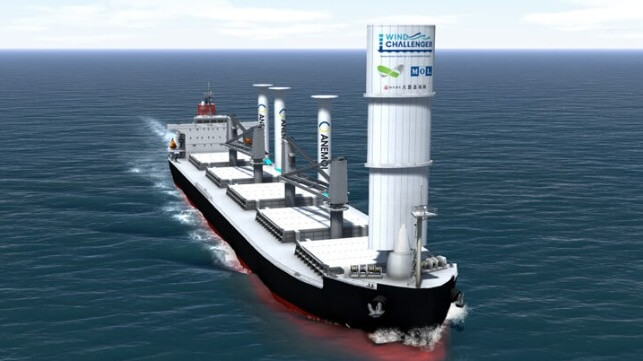R&D Seeks to Optimize Wind Propulsion for up to 50% Energy Savings

A three-year project funded by the European Union looks to build on the growing interest in wind propulsion seeking to optimize the available technologies to dramatically improve the energy savings versus the current applications. The project, which is being led by the Dutch maritime research institute MARIN, will work with partners from the shipping industry and technology to optimize the propulsion systems and demonstrate the potential for wind propulsion.
According to MARIN, there are currently more than 15 commercial ships sailing with applications of wind-assisted propulsion. The main concepts that are being installed and tested on existing vessels include rotor sails and rigid or solid sails. However, according to the researchers, most of these applications are being done without re-considering the overall ship design and operations. As such, they believe it is limiting the attainable savings from deploying these technologies.
“With Optiwise we are re-thinking the design process and energy management of ships with wind propulsion, while still making sure that these ships conform to common operational and regulatory requirements,” wrote MARIN in its objectives statement.
The EU, which is supplying over $5 million in funding for the project, calls for solutions for energy savings of at least 10 percent for single measures and 20 percent for combined measures. The objective of the new project, known as Optiwise, is to develop and employ holistic design and control methods for ground-breaking new ship concepts utilizing wind propulsion while considering realistic operational scenarios. With these methods, the group expects average energy savings of between 30 and 50 percent when compared to equivalent conventional ships while ensuring operational feasibility in a realistic wind climate.
“We expect to enable and showcase much higher savings than what can be seen in the present market applications,” says Rogier Eggers, project manager at MARIN. The project will focus on three technologies exploring the design of a bulk carrier with a rotor sail, a tanker with a rigid sail, and a passenger vessel with a solid sail. According to Eggers, they will build on R&D already under development among the consortium partners while also re-thinking the design process and energy management of ships with wind propulsion.
The project will incorporate extensive simulations where disciplines such as aerodynamics, hydrodynamics, routing, and energy management will be explored and coordinated. Attention will be applied to ensure realistic operational applications of the developed designs. Among the testing will be model basin tests to assess maneuvering and seakeeping, as well as bridge simulations to assess crew operation, and land-based wind propulsion tests to verify better control.
Euronav, which is one of the partners in the project, highlights the need to use technologies to go beyond the focus on fuel to achieve emissions objects for the maritime industry. “Zero emission fuels are assumed to be the main solution,” says Konstantinos Papoutsis from Euronav discussing the effort to produce emissions reduction. “However, sufficient and affordable supply of such fuels is highly uncertain for the foreseeable future, which means that energy saving on board is expected to be increasingly important, both environmentally and economically.”
The partners working together on the project which will be coordinated by MARIN, include Core IC, SSPA, Ayro, Chantiers De L'Atlantique, Flikkema Innovation Management & Consultancy, Wartsila Netherlands, Universita Degli Studi Di Genova, Euronav and Anemoi Marine Technologies.
